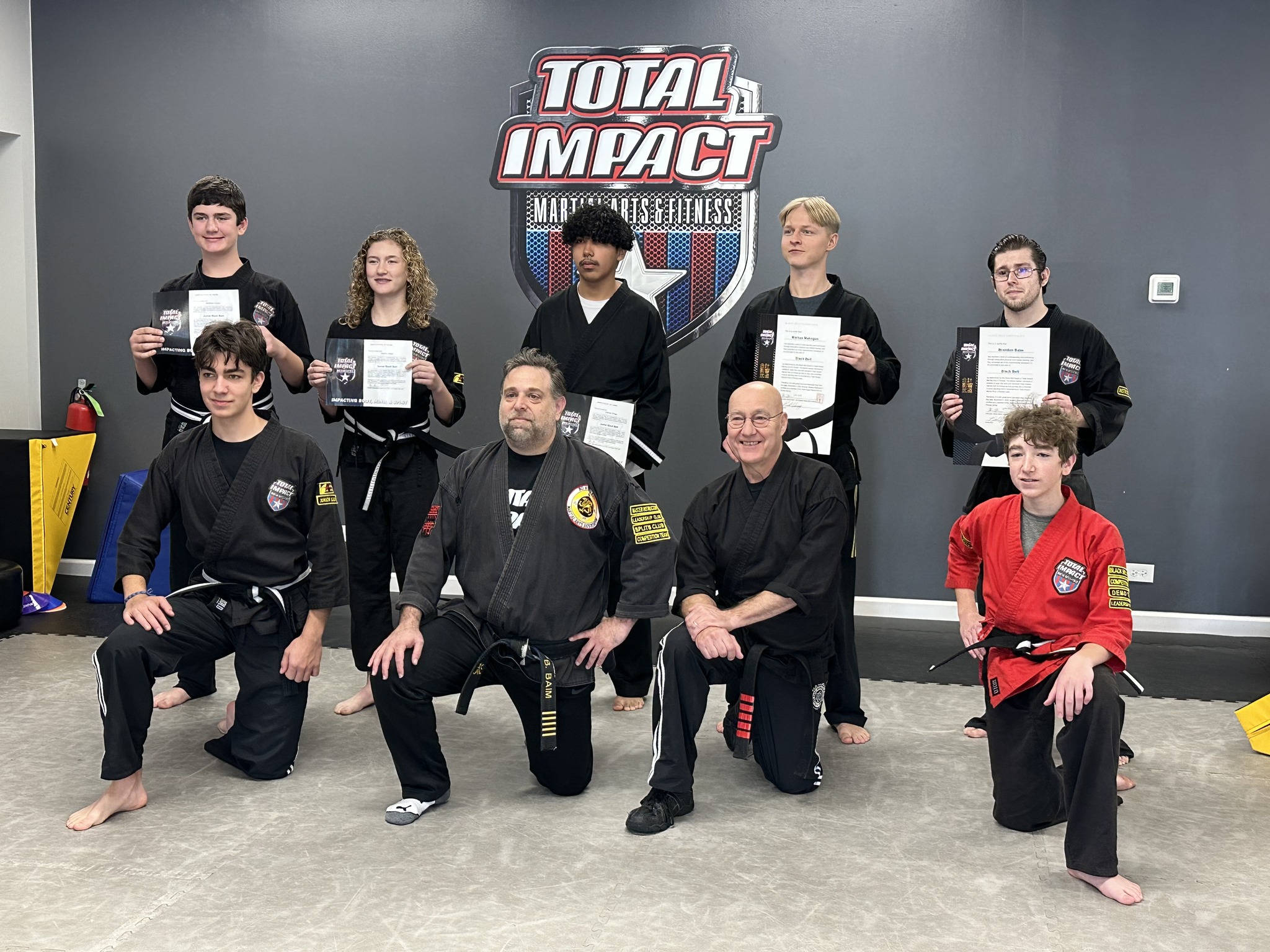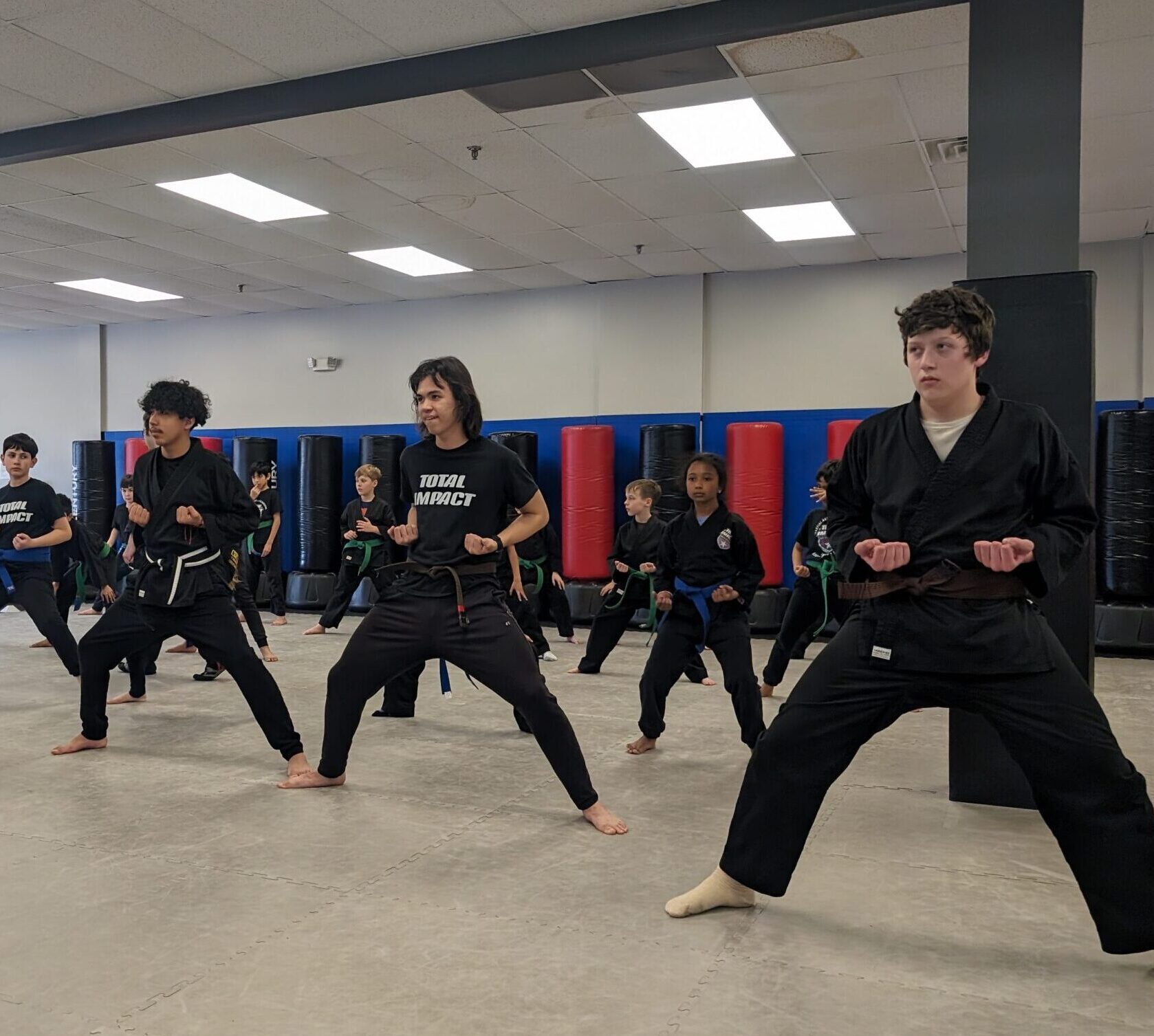You’ve begun karate (or another style of martial art) and you’re looking forward to that prized black belt—great job for having such a motivational goal! Now, however, the burning question on everyone’s mind is, “How long does it take to become a black belt?” The real answer? It depends. It can be different for every student. At Total Impact, we’re here to encourage you to stay dedicated to your martial arts training and steadily make progress. Keep in mind, it’s about the journey – not the destination!
Each martial art training and school varies when it comes to belt rankings and progress. Generally speaking, striking arts such as Karate and Taekwondo tend to have students attain a first-degree black belt in around 3–6 years of regular practice. Grappling arts, on the other hand, may take much longer – for instance, Brazilian Jiu-Jitsu is renowned for being among the slowest, typically taking around 10 years of commitment before attaining a black belt. Judo and Aikido usually fall somewhere in between (approximately 3–6 years for Judo and 4–5 years for Aikido in most schools).
- Karate (and Taekwondo): Most instructors anticipate around 3–5 years of consistent classes to test for a black belt.
- Taekwondo: Like Karate, usually around 3–5 years with consistent practice.
- Judo: Usually 3–6 years, based on training intensity.
- Aikido: Usually 4–5 years of consistent training.
- Brazilian Jiu-Jitsu: Typically 8–12 years (approximately a decade) for most students.
The length of time to become a black belt isn’t fixed – it depends on the art, the pace of the dojo, and even the frequency that you train. How often are you coming to class and belt testing? In some dojos, the students train 3–4 times per week and move ahead faster; others take it more slowly or may require more time. The important thing to remember is that black belt is a milestone, not a guarantee after a fixed period. What really determines your timeline is your skill, consistency, and dedication – qualities we’ll explore below.
Factors That Affect Your Black Belt Timeline
There’s no magic formula for how long to become a black belt. It’s ultimately a combination of things: the particular martial art, how often you train, your innate talent, and even the age at which you begin. Some schools of martial arts make students wait out a minimum period or come back to class a specified number of times for each belt, whereas others allow students to test whenever their teacher deems them prepared. At Total Impact, we don’t have a set schedule; progress is dependent on what you can do, not necessarily how long you’ve been around. We judge every student’s capabilities individually and determine if they are ready to receive a Black Belt based on hard work and ongoing commitment.
For example, two students may train twice a week for one year, for instance, and they may both train that same amount of time, but one may learn techniques quickly and become eligible for a new belt sooner than the other, who requires more practice but on some techniques. As one manual points out, “consistently training can greatly cut” the time it takes to become a black belt. That is to say, the more often you train and pay attention to development, the quicker you’ll be advancing. Conversely, if you only show up from time to time, it will naturally prolong the path.
In short, dedication matters more than the calendar. Excellence takes time and cannot be rushed!
What is the Order of the Belts in Karate?

Each martial art has its own system of belts, but the concept is essentially the same: you begin at white (novice) and get progressively darker belts as you master more. With Karate (and at Total Impact’s Karate program), the colors usually go like this: White → Yellow → Orange → Green → Blue → Purple → Brown → Black. (Some schools add stripes or different colors, but that sequence covers the basics.) Each belt change reflects a new stage of learning. For instance, a white belt student might spend a few months learning fundamentals before testing for yellow belt, then continue climbing the ranks as they master more techniques and forms.
(Keep in mind that countries and styles may have additional belts or reversed order. For instance, a classic Japanese system had only White, Yellow, Green, Blue, Red, Black, a model that many Taekwondo schools followed. The actual colors aren’t as crucial as the notion that each color signifies your advancement.)
Stages of Belts in Karate:
Let’s break it down by art:
- Karate Belts: Our Total Impact Karate students move through the pattern above (white to brown to black). We also employ stripes on belts to indicate progress through ranks. Every stage has its own name or number (in a traditional Kyu/Dan system) and requirements you will need to display.
No matter what the actual colors are, each belt phase is part of your journey. Before you achieve your first-degree black belt, you’ll have progressed past all of the previous phases. Having this systematic progression (“stages of belts in Karate” and Taekwondo) keeps you engaged with definite objectives at every stage. There are accomplishments and life lessons learned throughout your entire martial arts journey, be sure to savor and appreciate each step you take!
Insights from Shihan Brian: Skill, Consistency, and Character
What does our senior instructor, Shihan Brian Baim, tell us about moving up in rank? In simple terms: talent and character equal time on the clock. As a martial arts practitioner for more than four decades, Shihan Brian stresses that getting each next belt is not just about proving actual improvement. He frequently tells students that “every challenge is a chance to become stronger and sharpen your capabilities.” In other words, if you’re struggling with a technique, that’s an opportunity to learn and improve for next time.
Rank progress isn’t handed out because you showed up – it’s earned through ongoing effort. Shihan Brian values students who are regular in attending classes, training with proper form, and who have respect and discipline in class. These qualities of character (such as perseverance, humility, and concentration) mean a great deal.
In short, attitude and consistency propel you ahead. Concentrate on perfecting your technique, continue to come to class, and show the discipline you have acquired. At test time, instructors will observe that progress. Shihan Brian’s experience is a reminder that the students who continue to show up, train hard, and learn from failure are the ones who advance through the belts confidently.
Common Myths About Black Belts
There are plenty of myths about black belts. Let’s clear up a few:
- Myth: A black belt will follow X years of training. Reality: There’s no universal deadline. Some individuals in one dojo may achieve black belts in 3–4 years, and others may take longer. It just depends on how fast you learn and how frequently you train. What you want to do is really earn each rank.
- Myth: Black belt is the ultimate finish line. Reality: Actually, earning your first-degree black belt is just the beginning of a deeper journey. Many martial arts practitioners say a black belt simply means you’ve mastered the basics well enough – now the real learning starts. Higher degrees (2nd Dan, 3rd Dan, etc.) come with more study. As one guide reminds us, “a black belt is ultimately just a symbol. The real test of a martial artist is in their ability, knowledge, and living up to the principles of their art”. That is, the color of your belt doesn’t determine your value or capability.
- Myth: All black belts are the same. Reality: Each school and style has different criteria. Also, each black belt is only as proficient as their consistent training. A first-degree black belt is still a developing belt. And don’t forget, in Total Impact, we understand that black belt is merely the stepping stone – 2nd, 3rd (and further) Dan degrees exist beyond the first degree.
The takeaway here is this: belts are milestones, not destinations. They indicate progress and not perfection. Rather than obsessing over “how long” or “when,” become interested in what you’re learning and how you’re growing with each stage. Savor the challenges and lessons associated with every belt test. That way of thinking will take you a lot farther than any timeline myth.
Ready to Begin Your Journey at Total Impact?
So, how long to become a black belt? The answer begins with you: how diligently YOU train, how willing you are to learn, and how much you appreciate the process. If you show up, do your part, and accept the learning (as Shihan Brian and our instructors ask you to), the rank will come along in its own good time.
If you’re eager to begin your own martial arts journey, Total Impact Martial Arts is where you belong. We’re open to new students and experienced competitors of all ages. Contact us or join us for a free trial class to find out what our karate programs are all about. Let us assist you in setting goals, becoming confident, and making that first step on your black belt path. We can’t wait to assist you in becoming your own personal best – belt by belt!



